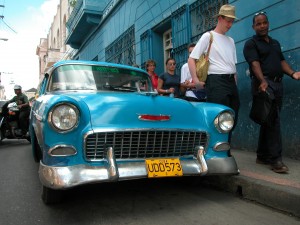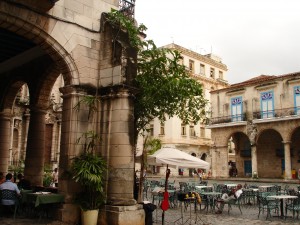The Taste of Cuban Cuisine
Posted on January 16th, 2014 by Samuel Max in Uncategorized | No Comments »
Understandably the food in Cuba takes influences from other cultures, noticeably the Spanish, but also African, Caribbean, and Taino. What results is a delicious blend of unique flavors and spices that make the Cuban cuisine a unique blend of its own.
Typically, meals in Cuba will base themselves around a staple of rice and beans, “arroz y frijol,” such as the popular arroz con pollo, or chicken and rice. Despite the apparent limitations of this, Cuban cuisine provides a wide array of tastes and palettes that you might be surprised by.
Moros y Cristianos, which oddly translates to “Moors and Christians,” due to the early settlers in Cuba, is a meal of black beans and rice, and arguably the most popular meal served at almost all Cuban restaurants.
Lechón Asado, A beautiful roast pork. The whole pig is cooked until good and crispy, but the secret is marinating the pig in mojo…
Mojo — Not the English “mojo,” although it does work some magic; this is a popular sauce in Cuba, consisting of garlic, olive oil and citrus juice; it’s most often used to marinate roast pork or added to potatoes.
Boliche is a meal featuring roast beef stuffed with chorizo sausages, cooked in a wine broth until tender and often served with white rice and a mixture of potatoes, carrots and olives.
The Mixto is a sandwich and popular lunch item. What sets this sandwich apart from your usual breaded friend is that the bread is made with the inclusion of lard or vegetable shortening, then placed around a mixture of roast pork, serrano ham, swiss cheese, dill pickles and mustard.
Most Cuban desserts have a creamy consistency to offset the hot and spicy meals. To that end, the most popular after dinner delicacies are Flan, Tres Leches Cake (made by soaking the cake in a mixture of condensed milk, evaporated milk and cream), and Arroz con Leche (rice pudding).
While we’re on the subject of things to order while in Cuba, we should should mention the drinks, as Cuba is well known to provide some good ones. The Cuba Libre is a mixture of white rum, cola and lime — the name is “free Cuba.” The Daiquiri is a family of cocktails based on the ingredients of rum, citrus and sugar. Lastly, the Mojito, this Cuban highball revolves itself around white rum, sugar, lime juice, sparkling water and mint.
So there you have it — the best and most tasteful Cuban selections that are well worth taking a bite out of. If you’re on your way over there and looking forward to this incredible array of flavor, bear in mind you might want to brush up on your Spanish, so as you can read the menu and order your food — Even after a few to many mojitos! If you need a little help getting your Spanish up to standard, consider taking some classes, or inquire about anything you’re not sure of.






